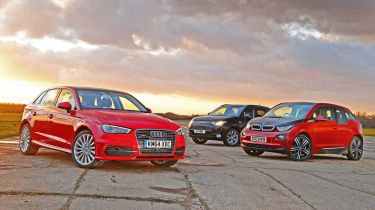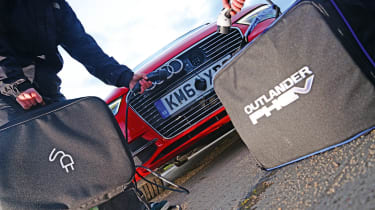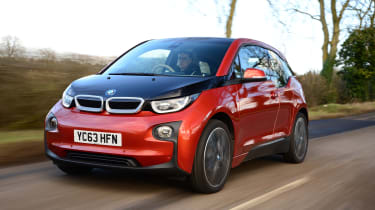Audi A3 e-tron vs BMW i3 & Mitsubishi Outlander PHEV
Plug-in cars promise great efficiency, but is Audi’s new A3 e-tron hybrid a better bet than range-extending i3 and Outlander?
Eco-friendly plug-in models are slowly gaining in popularity, so it’s no real surprise that after decades of experimentation Audi has finally decided to jump on the petrol-electric bandwagon.
The new A3 e-tron is based on the classy A3 Sportback, and packages together a 1.4-litre petrol turbo and 75kW motor, while a compact lithium-ion battery pack sits under the back seat. Its raw statistics certainly look compelling, with a 31-mile claimed electric range, CO2 emissions of 37g/km and 176.6mpg economy.
Just as importantly, Audi says these figures don’t come at the expense of the standard Sportback’s space, refinement and upmarket appeal.
However, there are many different ways to package the perfect plug-in, as our other contenders here prove. Mitsubishi’s rugged Outlander PHEV claims to deliver all the practicality of the standard model, but – with a 30-mile electric range – city car-humbling costs.
Completing our trio is BMW’s daring i3 Range Extender, which sets the class standard for efficiency, design and driving dynamics.
• Mitsubishi Outlander PHEV review
Click the links above to read individual reviews, and scroll down to see which is the best plug-in hybrid car in this test...
Head-to-head
Counting the cost
For many potential buyers, particularly business users, a plug-in’s big appeal is its running costs. The combination of ultra-low CO2 emissions and the ability to run in relatively cheap electric-only mode means some serious savings can be made. For instance, a higher-rate earner will face a £698 annual Benefit in Kind tax bill with the A3 e-tron, while an A3 1.6 TDI Sport S tronic will set them back £1,553.
Used - available now

2021 Mercedes
A-Class
50,217 milesAutomaticPetrol1.3L
Cash £18,387
2023 Land Rover
Range Rover Evoque
18,682 milesAutomaticDiesel2.0L
Cash £33,995
2019 BMW
1 Series
48,573 milesAutomaticPetrol1.5L
Cash £13,987
2017 Ford
Fiesta
38,600 milesManualPetrol1.2L
Cash £6,100Mitsubishi PHEV drivers make even bigger savings, with top-rate tax payers saving a huge £2,273 annually over the diesel equivalent. That’ll help buy a lot of fuel –which is good news, because unless you charge up every day and limit your mileage to a short commute, the Outlander will cost at the pumps. With the petrol engine running, it’ll struggle to crack 30mpg.
As with all our cars, you should plug the PHEV into the mains as often as possible. A full charge on all three will cost no more than a few pounds, but with its potential 100-mile range the BMW will go furthest on a full battery.
So the savings are there, but only if the car fits your lifestyle and motoring needs. If you can’t get to a socket daily, the fuel bills will start to add up – particularly on the PHEV and e-tron, which can recharge on the move but only at the cost of even heavier fuel use.
However, this tech is improving all the time, and it won’t be long before a car with a petrol generator for emergency use and a Tesla Model S-rivalling 300-mile electric range arrives. Until then, you’ll have to do your sums carefully and ensure these compromised cars fit with your motoring requirements.
Verdict
1st place: BMW i3
None of our contenders here is perfect, but the brilliant i3 puts eco-friendly credentials into the most usable, everyday package. Designed from the ground up as an EV, it has the longest battery range, boldest looks and best-packaged cabin. While the generator isn’t ideally suited to long motorway stints, it relieves range anxiety. This is the best alternative-fuel model.
2nd place: Audi A3 e-tron
It’s very easy to be seduced by the e-tron’s upmarket badge, classy cabin and penny-pinching on-paper costs, as well as its punchy performance. However, the hybrid set-up feels less well resolved than rival range-extenders, while the batteries’ extra weight blunts the drive. Finally, if you use the car for long journeys, fuel economy suffers, too.
3rd place: Mitsubishi Outlander PHEV
If you want space, rugged SUV styling and low company car tax bills, then the Outlander PHEV makes a certain amount of sense. Yet the petrol engine is thirsty, the interior feels low-rent and the driving experience lags behind that of the best 4x4s. Finally, in GX3h trim it lacks the standard kit you’d expect on a car costing nearly £30,000.
Key specs:
| BMW i3 with Range Extender | Audi A3 Sportback e-tron | Mitsubishi Outlander PHEV GX3h | |
| On-the-road price/total as tested | £29,130*/£36,625 | £29,950*/£32,500 | £28,249*/£28,249 |
| Residual value (after 3yrs/36,000) | £9,001/30.9% | £13,298/44.4% | £11,243/39.8% |
| Depreciation | £20,129 | £16,652 | £17,006 |
| Annual tax liability std/higher rate | 341/£682 | £349/£698 | £332/£665 |
| Annual fuel cost (12k/20k miles) | £922/£1,537 | £1,813/£3,021 | £2,020/£3,366 |
| Ins. group/quote/road tax band/cost | 21/£383/A/£0 | 29/£390/A/£0 | 26/£388/A/£0 |
| Cost of 1st/2nd/3rd service | £375 (5yrs 60k) | TBC | £500 (three services) |
| Length/wheelbase | 3,999/2,570mm | 4,312/2,630mm | 4,655/2,670mm |
| Height/width | 1,578/1,775mm | 1,424/1,785mm | 1,680/1,800mm |
| Drivetrain | Elec. motor/2cyl in-line | Elec. motor/4cyl in-line | 2 x elec. motor/4cyl |
| Generator/engine | 647cc | 1,395cc | 1,998cc |
| Peak power/revs | 168/0 bhp/rpm | 201^/5,000 bhp/rpm | 200^/4,500 bhp/rpm |
| Peak torque/revs | 250/0 Nm/rpm | 250/1,600 Nm/rpm | 190/4,500 Nm/rpm |
| Transmission | Single-speed auto/rwd | 6-spd auto/fwd | Single-speed auto/4WD |
| Fuel tank capacity/spare wheel | 9 litres/repair kit | 40 litres/repair kit | 45 litres/repair kit |
| Boot capacity (seats up/down) | 260/1,100 litres | 280/1,120 litres | 463/1,691 litres |
| Kerbweight/payload/towing weight | 1,315/415kg/N/A | 1,540/510kg/N/A | 1,810/500/1,500kg |
| Turning circle/drag coefficient | 9.9 metres/0.30Cd | 10.9 metres/N/A | 10.6 metres/N/A |
| Basic warranty (miles)/recovery | 3yrs (unlimited)/3yrs | 3yrs (60,000)/3yrs | 5yrs (62,500)/3yrs |
| Service intervals/UK dealers | Variable/44 | Variable/34 | 12,500 miles (1yr)/113 |
| Driver Power manufacturer/dealer pos. | 10th/22nd | 12th/26th | 23rd/19th |
| Euro NCAP: Adult/child/ped./stars | 86/81/57/4 | 82/78/66/5 | 88/84/64/5 |
| 0-60/30-70mph | 7.2/6.5 secs | 7.9/6.6 secs | 10.2/10.0 secs |
| 30-50/50-70mph | 2.3^^/4.2 secs^^ | 3.5/4.8/6.3/8.0 secs | 3.5^^/6.5 secs^^ |
| Top speed | 93mph | 138mph | 106mph |
| Braking 70-0/60-0/30-0mph | 52.9/38.3/9.5m** | 51.2/37.9/9.3m** | 51.4/37.1/9.1m** |
| Noise levels outside/idle/30/70mph | N/A/N/A/64/73dB | 60/52/62/71dB | 68/48/68/69dB |
| Auto Express econ. (mpg/mpl)/range | 63.3/13.9/125 miles | 32.2/7.1/283 miles | 28.9/6.4/286 miles |
| Govt combined economy | 470.0mpg | 176.6mpg | 148.0mpg |
| Govt combined economy | 103.6mpl | 38.8mpl | 32.5mpl |
| Actual/claimed CO2/tax bracket | 103/13g/km/5% | 203/37g/km/5% | 226/44g/km/5% |
| Airbags/Isofix/park. sensors/camera | Six/yes/yes/£790 | Seven/yes/yes/£275 | Seven/yes/yes/no |
| Climate control/leather/heated seats | Yes/£2,000/yes | Yes/£1,115/£260 | Yes/£1,500/no |
| Metallic paint/LED lights/keyless entry | £530/yes/£330 | £525/yes/yes | £500/no/yes |
| Sat-nav/USB/DAB radio/Bluetooth | Yes/yes/yes/yes | Yes/yes/yes/yes | No/yes/no/yes |
| Stability/cruise control | Yes/yes | Yes/£225 | Yes/yes |














